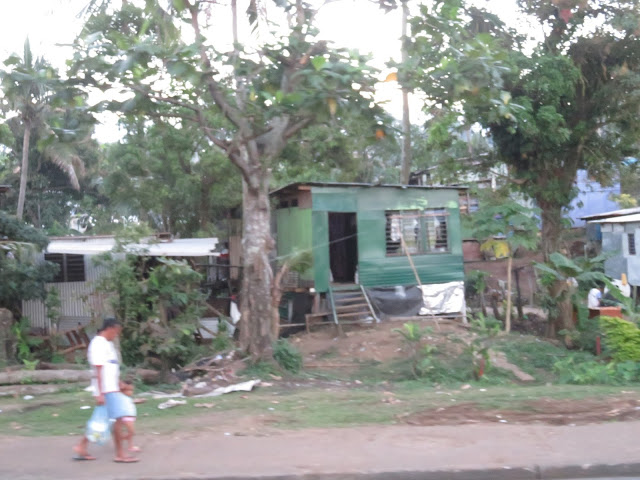Thursday, 30 June 2016
Fiji - maps and context
Fiji from space (www.wired.com) shows Vanua Levu (north) and Viti Levu (south). I like this image because you can see the relief and vegetation, the islands that constitute the nation, and the reefs.
This image shows more of the political context of Fiji. Unlike the Caribbean with the gravity of US hegemony, Fiji feels the political and economic weight of Australia, New Zealand, Japan, China, and Korea, with emphasis on the anglophone nations, which share a British colonial history.
The British colonial influence is evident in the Fijian currency and flag, both of which have undergone transition to represent a post-independent future. While the Queen's portrait has been replaced by Fijian icons on the currency, the flag is still to be revealed sometime this year. Former naval commander, Frank Bainimarama, assumed power after the 2006 coup and was elected as Prime Minister by large majority in 2014.
Monday, 27 June 2016
20-27 June 2016 - Vanua Levu Bulileka Village; got sick; laptop died
I left for Vanua Levu, Fiji's second largest island, on Monday June 20th. I was a tag-along on a geomorphology fieldtrip with the environmental science students (a class of 38). The students and I stayed in a village of just under 50 households.
On the third day, I became ill - I was cold and shivering and couldn't keep down any food.
On return to Viti Levu, Suva, I discovered my laptop wouldn't boot.
I am now relegated to the Departmental laptop until I have an alternative.
Consequently... no posts for the time being.
On the third day, I became ill - I was cold and shivering and couldn't keep down any food.
On return to Viti Levu, Suva, I discovered my laptop wouldn't boot.
I am now relegated to the Departmental laptop until I have an alternative.
Consequently... no posts for the time being.
Saturday, 18 June 2016
Squatting - Play, pay, and pray in Suva environs of informal settlements
 |
| Child's play in a parkette near to an informal settlement in greater Suva, Fiji. |
 |
| Veiquwawa Seventh Day Adventist - located in an informal settlement in Greater Suva. |
Squatting - taken from the bus on the way into town via two different routes - Fiji
 |
| This photo and the two that follow were taken about 5pm in the afternoon on Saturday June 18th on the bus heading back to Nabua. You can see the river clearly in the google link provided which also shows the haphazard unplanned settlement on the flood plain. |
 |
| Clearly depicting a demolished dwelling, whether it is turned to tinder by nature or design is unknown. |
 |
| Rickety start for youth born into these conditions. Site 2, includes this and the two photos that follow. Indeterminate location for now, but I will edit when facts present themselves. |
 |
| Relatively large, private, but precarious living due to a combination of insecurity of tenure and inadequate construction with poor materials. |
 |
| Strewn garbage worsened by a lack of facilities and service provision. |
Vehicles cooperating for time efficiency - Fletcher Road bottleneck (Vatuwaqa Bridge - The journey to school - Central Transport Co. Ltd - The Yellow Bus (70cents one way, or 1dollar if you continue to town!)
Vehicles cooperating for time efficiency - Fletcher Road bottleneck (Vatuwaqa Bridge - The journey to school - Central Transport Co. Ltd - The Yellow Bus (70cents one way, or 1dollar if you continue to town!)
CARPIMS Mobility, International Office, University of the South Pacific, official welcome tea - Friday June 17th. Picture below, left to right: Dr. Kissoon visiting from the Department of Geography, University of the West Indies; Mr. St. John; USP International office; Ms. Priyadarshani, USP International Office; and Mr. Anthony, USP International Office. All three staff members of USP are Fijian, indicating the country's ethnic diversity.
USP Main Campus with Tsunami warning. A botanical haven to relax and regenerate young minds. A short shuttle or 10 minute walk from the south campus.
 |
| The main campus library. Note the towering palms and the open louvered windows. There is no air-conditioning. The building also has cyclone shutters for the stormy season. |
 |
| Move inland to higher ground - away from this picturesque picnic pit - in case of Tsunami. In Trinidad and Tobago, it is common to see assembly area signs in communities in case of earthquake; however, the hazard that places Fiji at risk is cyclonic activity and, it seems, seismic sea waves. Comparing the Environmental Vulnerability Index (EVI) of TT and Fiji, the former is "extremely vulnerable" while the latter is "highly vulnerable". Fiji's vulnerability, according to the EVI comes from cyclones, landslides, and isolation, amongst other things. Click here for more information on the EVI. |
Thursday, 16 June 2016
Showcase facepainting and Japanese paper balloons: My cheeky 8-year old housemate!
Hannah the dog, and two of the three resident cats, bright-eyed Leo and sleepy Garfield (siblings).
Subscribe to:
Posts (Atom)



















